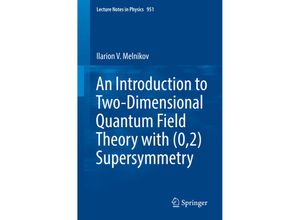This book introduces two-dimensional supersymmetric field theories with emphasis on both linear
and non-linear sigma models. Complex differential geometry in connection with supersymmetry
has played a key role in most developments of the last thirty years in quantum field theory and
string theory. Both structures introduce a great deal of rigidity compared to the more general
categories of non-supersymmetric theories and real differential geometry allowing for many
general conceptual results and detailed quantitative predictions. Two-dimensional (0 2)
supersymmetric quantum field theories provide a natural arena for the fruitful interplay
between geometry and quantum field theory. These theories play an important role in string
theory and provide generalizations still to be explored fully of rich structures such as
mirror symmetry. They also have applications to non-perturbative four-dimensional physics for
instance as descriptions of surface defects or low energy dynamics of solitonic strings in
four-dimensional supersymmetric theories. The purpose of these lecture notes is to acquaint the
reader with these fascinating theories assuming a background in conformal theory quantum
field theory and differential geometry at the beginning graduate level. In order to investigate
the profound relations between structures from complex geometry and field theory the text
begins with a thorough examination of the basic structures of (0 2) quantum field theory and
conformal field theory. Next a simple class of Lagrangian theories the (0 2) Landau-Ginzburg
models are discussed together with the resulting renormalization group flows dynamics and
symmetries. After a thorough introduction and examination of (0 2) non-linear sigma models the
text introduces linear sigma models that in particular provide a unified treatment of
non-linear sigma models and Landau-Ginzburg theories. Many exercises along with discussions of
relevant mathematical notions and important open problems in the field are included in the
text.

